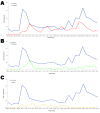Spread of adenovirus to geographically dispersed military installations, May-October 2007
- PMID: 20409365
- PMCID: PMC2954003
- DOI: 10.3201/eid1605.091633
Spread of adenovirus to geographically dispersed military installations, May-October 2007
Abstract
In mid-May 2007, a respiratory disease outbreak associated with adenovirus, serotype B14 (Ad14), was recognized at a large military basic training facility in Texas. The affected population was highly mobile; after the 6-week basic training course, trainees immediately dispersed to advanced training sites worldwide. Accordingly, enhanced surveillance and control efforts were instituted at sites receiving the most trainees. Specimens from patients with pneumonia or febrile respiratory illness were tested for respiratory pathogens by using cultures and reverse transcription-PCR. During May through October 2007, a total of 959 specimens were collected from 21 sites; 43.1% were adenovirus positive; the Ad14 serotype accounted for 95.3% of adenovirus isolates. Ad14 was identified at 8 sites in California, Florida, Mississippi, Texas, and South Korea. Ad14 spread readily to secondary sites after the initial outbreak. Military and civilian planners must consider how best to control the spread of infectious respiratory diseases in highly mobile populations traveling between diverse geographic locations.
Figures



Similar articles
-
Health care transmission of a newly emergent adenovirus serotype in health care personnel at a military hospital in Texas, 2007.J Infect Dis. 2009 Dec 1;200(11):1759-65. doi: 10.1086/647987. J Infect Dis. 2009. PMID: 19842979
-
Outbreak of severe respiratory disease associated with emergent human adenovirus serotype 14 at a US air force training facility in 2007.J Infect Dis. 2009 May 15;199(10):1419-26. doi: 10.1086/598520. J Infect Dis. 2009. PMID: 19351260
-
Febrile Respiratory Illness Associated with Human Adenovirus Type 55 in South Korea Military, 2014-2016.Emerg Infect Dis. 2017 Jun;23(6):1016-1020. doi: 10.3201/eid2306.161848. Emerg Infect Dis. 2017. PMID: 28518038 Free PMC article.
-
Molecular epidemiology of adenovirus type 7 in the United States, 1966-2000.Emerg Infect Dis. 2002 Mar;8(3):269-77. doi: 10.3201/eid0803.010190. Emerg Infect Dis. 2002. PMID: 11927024 Free PMC article. Review.
-
Six Decades of Human Adenovirus Type 4 Infections Reviewed: Increasing Infections Among Civilians Are a Matter of Concern.Clin Infect Dis. 2021 Aug 16;73(4):740-746. doi: 10.1093/cid/ciab146. Clin Infect Dis. 2021. PMID: 33693635
Cited by
-
Respiratory Infections in the U.S. Military: Recent Experience and Control.Clin Microbiol Rev. 2015 Jul;28(3):743-800. doi: 10.1128/CMR.00039-14. Clin Microbiol Rev. 2015. PMID: 26085551 Free PMC article. Review.
-
Epidemic viral pneumonia and other emerging pathogens.Clin Chest Med. 2011 Sep;32(3):451-67. doi: 10.1016/j.ccm.2011.05.010. Clin Chest Med. 2011. PMID: 21867815 Free PMC article. Review.
-
Cross-sectional study of the relationship of peripheral blood cell profiles with severity of infection by adenovirus type 55.BMC Infect Dis. 2014 Mar 19;14:147. doi: 10.1186/1471-2334-14-147. BMC Infect Dis. 2014. PMID: 24646014 Free PMC article.
-
Adenovirus: Epidemiology, Global Spread of Novel Serotypes, and Advances in Treatment and Prevention.Semin Respir Crit Care Med. 2016 Aug;37(4):586-602. doi: 10.1055/s-0036-1584923. Epub 2016 Aug 3. Semin Respir Crit Care Med. 2016. PMID: 27486739 Free PMC article. Review.
-
A new human DSG2-transgenic mouse model for studying the tropism and pathology of human adenoviruses.J Virol. 2012 Jun;86(11):6286-302. doi: 10.1128/JVI.00205-12. Epub 2012 Mar 28. J Virol. 2012. PMID: 22457526 Free PMC article.
References
-
- Friedman M, Grayston JT, Loosli CG, Pierce WE, Whiteside JE, Woolridge RL. Studies on acute respiratory illness in naval recruits, with emphasis on adenoviruses (APC-RI). J Infect Dis. 1956;99:182–7. - PubMed
-
- Berge TO, England B, Mauris C, Shuey HE, Lennette EH. Etiology of acute respiratory disease among service personnel at Fort Ord, California. Am J Hyg. 1955;62:283–94. - PubMed
-
- Pierce WE, Peckinpaugh RO, Frazier WE, Griffin JP, Greenberg BH, Jackson GG. Live and killed adenovirus vaccines for the prevention of acute respiratory disease in recruits. Antimicrob Agents Chemother. 1965;5:55–8. - PubMed
-
- Dudding BA, Topp FH Jr, Winter PE, Buescher EL, Lamson TH, Leibovitz A. Acute respiratory disease in military trainees: the adenovirus surveillance program, 1966–1971. Am J Epidemiol. 1973;97:187–98. - PubMed
Publication types
MeSH terms
LinkOut - more resources
Full Text Sources
Other Literature Sources
Medical
